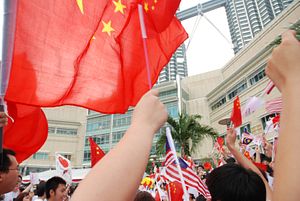The fact that race relations in Malaysia aren’t in the best shape is old news. With the Chinese and Indian diasporas respectively making up 23 and 7 percent of the population, it’s difficult to talk about Malaysian politics without mentioning either group. But while it certainly hasn’t been smooth sailing for the Indian-Malay relationship, issues to do with the Chinese diaspora have historically been more salient, given its much more visible presence both politically and economically. Chinese-Malay tensions have become evermore relevant in light of the weakening Barisan Nasional ruling coalition and new developments in the South China Sea.
In September, comments made by Chinese Ambassador to Malaysia Huang Huikang following a pro-government rally rocked the political sphere in Malaysia and even caused a mini firestorm to emerge on The Diplomat. In the same vein, there have been several intense debates recently over political terms used to describe the Chinese diaspora (see here and here).
While the Chinese do hold political power as part of the ruling coalition, it is their success in the economic realm that has been the main source of dissatisfaction for ethnic Malays. Right-wing groups often complain about a Chinese take-over of the country’s economy, and encourage ethnic Malays to unite under the idea of “ketuanan Melayu”, or Malay pre-eminence, against the Chinese domination of the economy. Ordinary Malays have adopted the rhetoric as their own, using social media as a tool to speak out against any indication that the Chinese are second-class or disadvantaged.
Looking purely at numbers, it does seem that the Chinese have it much better. Census data from 2014 show that the average monthly gross income for the Chinese is much higher than that of any other ethnic group in the country. Adding to this narrative are lists like the Forbes’ 50 Richest, which consistently reveal that the majority of Malaysia’s richest are of Chinese descent (in 2015, eight of the top 10 Malaysian nationals on the Forbes’ list were Chinese).
Under this banner, two intertwined narratives have been consistently marginalized: that of the mirage of Chinese dominance in Malaysian society, and that of the Chinese poor.
First of all, despite the lack of indication in the Malaysian constitution, there’s no debate over the fact that the prime minister must be of Malay origin, meaning that Chinese political power will always hit a brick wall. Furthermore, there is little support from the Chinese community for the Malaysian Chinese Association (MCA), the voice for the ethnic-Chinese population in government. Political observers agree that, that while they are vocal in the opposition, the Chinese have a largely insignificant voice in Malaysian parliament.
Secondly, it is the Malays, not the Chinese, that actually control most of the economy. Since the enactment of the New Economic Policy (NEP) in the 1970s — a set of affirmative action policies for ethnic Malays aimed to reduce inequality between them and their ethnic-Chinese counterparts — the Malays have monumentally improved their situation. They control most of the major banks, including the central bank, the government linked companies (GLCs), as well as constitute the majority of the top professional and highest-paying occupations in the private sector.
What the impressive statistics touting Chinese success obscure is that while there is a sizable ethnic Chinese middle class, income inequality is also most rampant within the Chinese population. All the wealth is concentrated within a few, and there is a large number of Chinese who are either below the urban poverty line or slightly above the poverty line. Furthermore, while many of the NEP measures are still in force protecting the ethnic-Malays, there is relatively little government support for non-Malays in poverty. Correspondingly, there is a dire lack of academic study and census focus on the Chinese poor.
Meanwhile the government certainly isn’t helping matters with its rhetoric. The “Bangsa Malaysia” policy introduced in the 1990s, aimed to create an inclusive national identity for all Malaysian residents, has evolved into a nebulous concept. Over the years the government hasn’t ceased to refer to the ethnic Chinese as “pendatang,” which means “immigrant” in Malay. Such language confirms, and often exacerbates, the distinctions that exist between Malaysian nationals. In early February Rural and Regional Development Minister Datuk Seri Ismail Sabri Yaakob used racial language to encourage Malay consumers to boycott Chinese-owned businesses that have been raising their prices.
In an interview with Hong Kong’s Phoenix Satellite TV following the controversial Low Yat Plaza incident in July, retired Malaysian Prime Minister Mahathir Mohamad (interestingly, the very person who introduced the Bangsa Malaysia policy) assured that the Chinese are “have [been] treated very well and feel very comfortable”.
While it’s true that settlement patterns and colonial legacies have disproportionately enabled the success of the Chinese diaspora in Malaysia, the narrative that currently surrounds Chinese-Malay relations in Malaysia is warped and often one-sided. If Malaysia wants to mitigate its severe Chinese-led brain drain and, as it claims, build a more inclusive country, it must invigorate efforts at fostering genuine dialogue on racial issues, rather than brushing them aside. After all, there are two sides to every story.

































